Commentary: Pro-Driver Group Evokes Open Roads — With More Cars?

Rob Toftness contributed this opinion piece. He is a member of the grassroots group Denver Bicycle Lobby and active on Twitter @NoSquish.
A group that wants to push more cars onto Colorado roads has written a flurry of opinion pieces with nonsensical ideas cut-and-pasted from one into the next recently — and the Denver Post and Colorado Sun have been happy to publish them.
The Freedom to Drive Coalition pretends to be a grassroots organization but is really tied to the Koch brothers, big oil and Colorado’s car dealers. The group argues against Denver’s efforts to increase the number of people the city’s streets can carry. Sara Almerri, the organization’s spokesperson, writes that improving walking, biking and public transportation will actually increase traffic congestion — and that somehow the opposite, allowing a growing population to cram more cars onto already clogged streets — is the best way to move forward.
She repeated this pattern last week in the Post with a piece, “End Denver’s unfair war on car commuters.”
The op-ed claims, “We all share the same goal — reducing pollution and emissions.”
I’m not sure how that is possible from an organization that opposed Colorado’s adoption of California’s zero-emission vehicle standards in the Colorado Sun and Denver Post.
If you followed her pieces with your pro-motorist bingo card, in both articles, you can plant your ink dauber firmly in these squares:
- Bikes are only for the young and fit
- Transit works great in New York, not in city X
- Grocery shopping by bike is hard
- Cars equal the American dream
- Freedom
- The Open Road
This last one is the one that I find the most interesting. Think of any car commercial ever and picture how many other vehicles you see on the road as they artistically drive through a downtown center. Not surprisingly, it is usually none.

Both articles evoke the image of open roads. But more cars equal less open roads. It seems to me that the Freedom To Drive Coalition is doing an excellent job of shooting themselves in the foot.
Cities haven’t had open roads for a long time. The reason for this, again, is cars. But Denver’s streets already carry a lot of people moving via other modes of transportation. These folks are in buses, cars, light rail, on bikes, skateboards, and scooters. Or they’re walking and rolling around under their own power. However, only one of these groups is given the majority of the space between the curbs.
A lot of people assume the roads were built for cars, but it’s important to note that we call it a public right of way for a reason. Denver once boasted an excellent streetcar network and folks riding to work alongside horse carts. Streets were a gathering place or a connection to a neighborhood and not just a thoroughfare for drivers.
Denver has some enormous streets. I ask that you read this sentence then close your eyes and think of some of them that have been the subject of bus and bike lane meetings recently: Broadway, 15th, 17th, and 18th Streets.
These are big streets. For example, 18th is roughly 48 feet across and has five lanes dedicated to cars. This includes three traffic lanes and two private vehicle storage lanes. You may know these as “parking.”
Now, let’s do some brainstorming.
Upgrade a lane to bus-only
A city bus can hold anywhere between 40 to 60 people. That’s potentially 40 to 60 cars off the road. The right of way now just got a little more open. There are still two lanes where the everyday people who the Freedom To Drive Coalition claims to represent can put the car’s top down and drive the wind blowing in their hair.
Add a bike lane
Then keep going. Take out a parking lane that most likely was used to store a vehicle for hours — by a person driving alone. Add in a protected bike lane. It’s wide enough to ride side-by-side and converse with your friend as you glide to your destination. It would also allow bicyclists to drop their worry that drivers are going to hit you. In this daydream, Mayor Hancock wisely added budget lines for fully protected infrastructure.

Add other livable streets amenities
Go a little further and remove the other car storage lane. You now have the space for another protected bike lane taking people in the opposite direction. Or you have opened valuable public space for a parklet, an art installation, vegetation, bike and scooter storage, wider sidewalks, or even dedicated curb space for deliveries so UPS and FedEx can stop blocking bike lanes. Remember, there are still two car lanes for drivers to crank some tunes and really take in that freedom.
So what have we accomplished in this National Association of City Transportation Officials-inspired daydream?
We have increased space for things that make a city livable and walkable. We’ve added space for travel modes other than cars, thereby enjoying the added benefit of removing cars from the road. We’ve kept two lanes for driving, but now because cars will be flanked by bike lanes, buses, and parklets, they won’t be rushing at dangerous speeds through downtown.
Denver is wisely updating its Complete Streets Design Guidelines to discourage high speeds and our newly brainstormed 18th Street would be no exception.
I dare say, I may be agreeing with the Freedom To Drive Coalition. We do need more open roads so we can reimagine spaces for more than just cars. Surely this is what they meant, right?
Streetsblog Denver needs your support. Give $5 per month.


